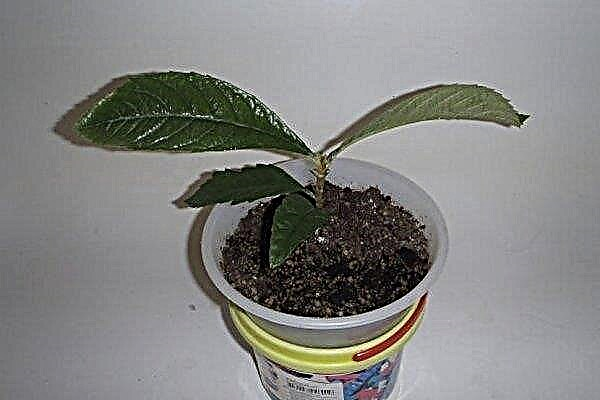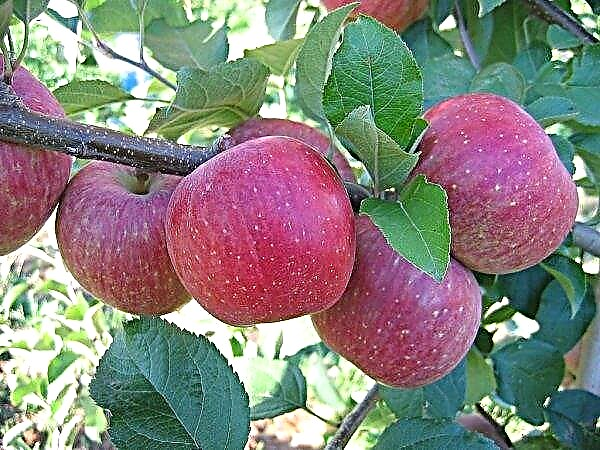Bright and beautiful tulips are grown in the country house of many gardeners, and the planting of the bulbs of these plants in the open ground is usually performed in the fall. But under certain conditions, you can plant flowers in the spring. In this case, tulips can bloom even this year, if the gardener prepares a suitable place for growing plants, correctly performs planting at the right time and provides the plants with the necessary care. More about all of this later in the article.
When to plant tulips in spring so that they can bloom
So that the bulbs planted in the soil sprouted and tulips bloom in the first year, the planting material is embedded in the soil in early spring.
When choosing a date, you must comply with the following requirements:
- planting is carried out in the period from late March to mid-May - the colder the climate in the region, the later the bulbs close up in the soil;
- the earth should dry out a little - excess dampness leads to root decay;
- tubers cannot be planted during strong winds - it blows off the ground from the bulb and can even tear it out of the ground;
- the earth should warm up to + 9 ° C at a depth of at least 10 cm;
- early varieties of flowers are planted in the first half of spring, and later - from mid-April;
- the air temperature at the time of planting the bulbs in the soil should be at least + 6 ° C.
Did you know? The world leader in tulip cultivation is the Netherlands. Over 3 billion of these bright colors are cut annually in the country.
How to plant
During spring planting, tulip bulbs are more difficult to root in the soil, so the flowering of plants is usually delayed for a month. In order to accelerate the emergence of seedlings and stimulate the appearance of buds in the year of planting, it is necessary to properly prepare planting material. It is equally important to choose a suitable area for the flowers and clearly follow the instructions for planting bulbs in the soil.

What you need for landing
In areas with a cold climate, spring planting of tulips in open ground is usually possible no earlier than the end of April, because until this time the soil is not warmed up enough by the sun. In this case, you can use the method of forcing flowers, so that the plants bloomed already in the current year. To do this, in early spring, it is recommended that the bulbs be planted in a container with earth, and after emergence, move them to the site.
When growing tulips for distillation, the following materials are used:
- wide container made of wood, plastic or ceramic;
- pebbles or small stones for laying the drainage layer in the tank;
- fertile soil mixture for flowers, consisting of an equal amount of humus, leaf and garden soil, with the addition of a small amount of peat and sand - you can buy ready-made soil in the store.

During planting of plants in an open area, it is dug up with a shovel. To break up large earthen clods, the soil surface is loosened with a rake.
How to prepare bulbs for spring planting
To accelerate the emergence of seedlings, it is necessary to properly prepare the planting material before planting in the soil.

To do this, take the following steps in turn:
- Inspect the bulbs, discarding damaged and damaged specimens.
- Fold the planting material in the refrigerator for 10-12 hours - this helps to harden the tubers before planting.
- Immediately before embedding in the soil, soak the bulbs in a pink solution of potassium permanganate for 30 minutes to disinfect.
- Peel the tubers from the outer skin so that they better absorb moisture and nutrients from the soil.
Important! You can peel tulip bulbs from their peels only with your hands. In this case, sharp instruments cannot be used, since there is a risk of damage to the tubers.
Site selection and soil preparation
Before planting tulips, you need to find a suitable place for them on the site, and also properly prepare the soil. This will help the bulbs quickly adapt to new conditions and reduce the risk of diseases and pests.
The plot for flowers must meet the following requirements:
- to be open to sunlight - for growth and lush flowering plants need warmth and light;
- to have light and loose soil of neutral acidity (sandy loam or loamy) - it passes water and air well, warms up faster;
- Keep away from drafts - under the influence of cold air currents, the flower’s immunity weakens and fungal diseases can occur.

Before planting, the soil in the selected area must be dug to the depth of the shovel bayonet. At the same time, fertilizers are added to enrich the earth with nutrients.
You can use ready-made store formulations for flowering bulbous plants or make a small amount of one of these components:
- potassium sulfate;
- rotted compost;
- wood ash;
- double superphosphate;
- phosphoric fertilizers;
- a piece of chalk.
Planting a plant
After preparing the site and planting material, they begin to directly plant the bulbs in the soil. Step-by-step instructions for planting flowers are presented below:
- Prepare small holes with a depth of 7 to 15 cm (depending on the size of the bulbs). The distance between adjacent recesses should be at least 10 cm.
- If the ground is not wet enough, pour a small amount of warm water on each well.
- Place the onion in the hole by turning it downside down. It is impossible to push a tuber into the ground.
- Sprinkle indentations with loose earth. Carefully level the surface of the soil on the bed.
- Sprinkle a little warm water on each onion.
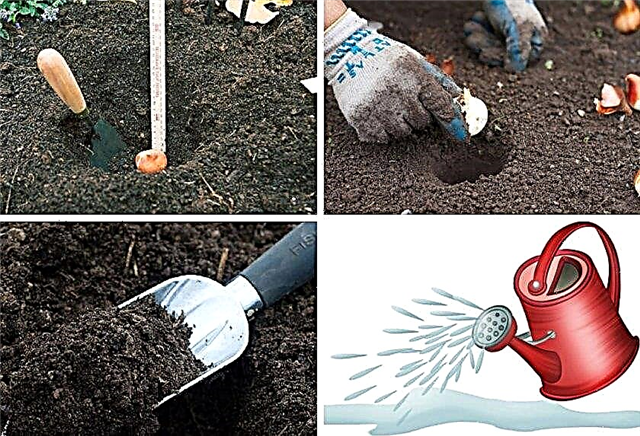
If tulips were grown by distillation, then they are transplanted from the container to an open area using the same algorithm. In order not to injure young plants once again, you can simply dig a container with sprouts into the soil.
Important! Re-planting tulips in the same area is possible only after 4 years. Otherwise, the risk of flower damage by pests and infections increases.
Proper flower care
It takes about 2-3 weeks to root the tulip bulbs. Further planting care consists mainly in regular watering and fertilizing. It is equally important to periodically loosen the soil in the beds and inspect the flowers for damage by diseases or pests. After flowering, tulips also require some care.
Watering and feeding
The main factors affecting the growth and flowering of tulips are proper watering and top dressing. They must be carried out according to certain rules, i.e. excess moisture and fertilizer in the soil can cause flower diseases and even lead to the death of plants.

The main features of feeding and irrigation of tulips are:
- watering is carried out as the top layer of the soil dries up;
- water is poured under the root so that the drops do not fall on the stem and leaves of the flower;
- for irrigation, it is recommended to use only room temperature water;
- about 1-30 m² of flower beds consume about 20-30 liters of liquid so that the earth is well moistened;
- fertilizers are applied 3 times per season - at the stage of the appearance of the first seedlings, at the beginning of flowering and after its completion;
- plants are fed with store-bought mineral fertilizers, following the instructions on the package, or make 50 g of a dry mixture of potassium, nitrogen and phosphorus on 1 m² of area (ratio of components 1: 2: 2);
- after embedding fertilizers in the soil, the bed is abundantly watered with water so that nutrients reach the roots of tulips faster.
Loosening
To improve the air permeability of the soil, as well as to facilitate the access of water and fertilizers to the roots of the plant, it is necessary to regularly loosen the soil in the beds with tulips. This procedure is carried out after every rain or watering, helping to eliminate the dense crust formed on the surface of the soil.

Loosening is carried out very carefully to a depth of not more than 4 cm, so as not to damage the flower bulbs. Weeds around the plants are removed as necessary and taken out of the site. Thanks to weeding, water and fertilizers are fully absorbed by the roots of the flowers, which contributes to the appearance of large buds.
Did you know? During World War II, Europeans consumed tulip tubers for food, replacing them with ordinary onions.
Disease Prevention and Treatment
Subject to the above recommendations for the preparation of planting material and care, tulips are rarely affected by diseases. But if this still happened, then you need to immediately take action and stop the further spread of infection.
The main diseases of the culture:
- Gray rot. The disease manifests itself as yellowish-gray spots on the surface of the stem and bulb. Over time, the affected areas increase in size, and a spore-bearing fungus forms on them.
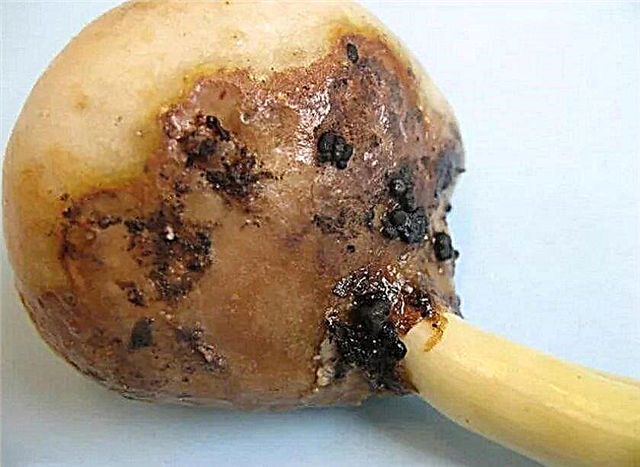
- Fusarium. The main symptoms of infection are stunting, yellowing of leaves and wilting of the plant. Soft brown patches appear on the tuber of the flower - rot.

- Rhizoctonia. This infectious disease develops on the tulip bulb, covering it with white spots. Over time, the affected areas acquire a brown color, and the white mycelium spreads to the soil around the plant stem.

- Tifulez. The disease has an infectious nature. The main symptoms are stunting, yellowing and dying of the roots of the bulb, redness of the leaves and their twisting. Sclerotia are formed inside the tuber, which lead to decay of the entire underground part of the plant.
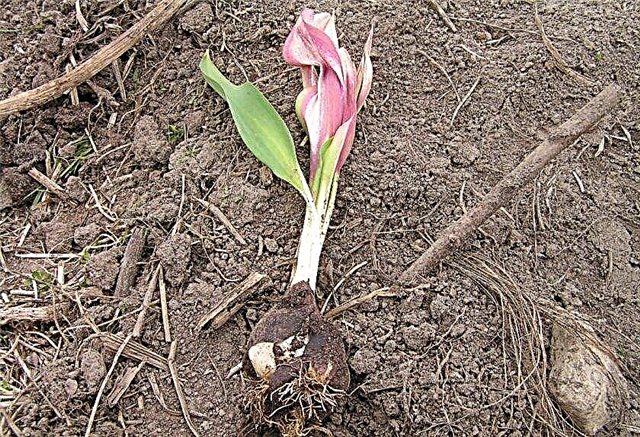
- White rot. A sign of infection is a cotton-like white coating on the stem, tuber and flower leaves. As the disease develops, brown areas containing fungal spores form on the plant.

- Motley. This viral disease is not treatable, and its symptoms are spots, strokes and stripes on the tulip petals. As a result of infection, the flower acquires an unusual color for a particular variety and fades.

- Bacteriosis. The disease has an infectious nature and affects all parts of the plant. Signs of infection include stunting, white edges of the leaves, yellowing of the veins, small ulcers on the buds and flowers, rotting of the bulb. Affected areas become soft over time and become covered with mucus.

For the treatment of fungal infections, special drugs are used (for example, Fundazolum, Topsin). When using them, you must strictly follow the instructions on the packaging. Infectious and viral diseases cannot be treated, so when they are found, affected specimens are dug up and burned.
Important! Of the pests, a bear, an onion tick and aphids can threaten plants. If these insects are found, the bed is treated with special preparations (for example, Actellic, Bazudin).
To prevent the occurrence of these problems, it is recommended to observe preventive measures:
- plant flowers in a suitable area;
- observe the regime of watering and top dressing;
- dig the soil before planting;
- observe crop rotation;
- choose high-quality planting material;
- properly prepare the bulbs for embedding in the ground;
- adhere to the recommended scheme of planting flowers;
- remove weeds;
- loosen the soil around the plants;
- timely destroy diseased plants on the site.

Tulip care after flowering
After flowering is complete, tulips also need some care. It includes such actions:
- fallen petals need to be removed from the site - they can rot, becoming a source of infection;
- after the completion of flowering, watering of the plants stops;
- when the stem of the flower turns completely yellow and dries, it is carefully cut;
- in areas with a mild climate, you can leave the bulbs to winter in the soil, covering them with a layer of peat mulch;
- in regions with cold winters, you need to dig up the tubers, dry them for a couple of days at room temperature, and then store them in a dark and cool place.
Did you know? Cut tulips can continue to grow even in a vase of water. In this case, the flower is able to add up to 3 cm in height.
A bright flower garden of tulips will decorate any summer cottage, and you can achieve the lush flowering of these plants this year, even under the condition of spring planting. Using the information presented in the article, even a novice gardener will be able to independently prepare a plot for growing flowers, properly plant the bulbs in the soil and provide seedlings with the necessary care.









